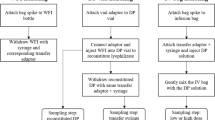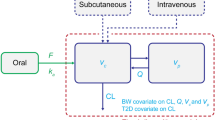Abstract
Purpose. To theoretically investigate the impact of gastric emptying half-time, intestinal transit time and the time for 85% in vivo dissolution on the peak concentration and area-under-the curve of model drugs.
Methods. Simulations were performed using mathematical models of gastrointestinal physiology and pharmacokinetics of model drugs with different gastrointestinal permeability. They were used to investigate the effect of different permutations of gastric emptying times, intestinal transit times, dissolution rates and effective permeabilities on the maximum plasma drug concentration and the area-under-the-curve of immediate release tablets relative to an oral solution (i.e., Cmaxtablet/ Cmaxsolution and AUCtablet/AUCsolution).
Results. The higher the permeability of the drug, the more sensitive the Cmax ratio is to dissolution rate and gastric emptying rate. As the intestinal transit time becomes more rapid, the sensitivity to T85% dissolution time and gastric emptying half-time increases. There is less dependence for the AUC ratio on the gastric emptying time and dissolution rate.
Conclusions. Under the assumptions of the models, the criterion of 85% dissolution in 15 minutes (T85%) for classifying a rapidly dissolving drug product is relatively conservative since the Cmax ratio exceeded 0.8 for a T85% dissolution time of one hour and a gastric emptying half-time faster than 0.2 hour over a wide range of permeabilities.
Similar content being viewed by others
REFERENCES
H. Lennernas, O. Ahrenstedt, R. Hallgren, L. Knutson, M. Ryde, and L. K. Paalzow. Regional jejunal perfusion, a new in vivo approach to study oral drug absorption in man. Pharm. Res. 9:1243–1252 (1992).
B. Lever-Trafit, M. S. Gruyer, M. Marjanovic, and R. C. Chou. Estimation of oral drug absorption in man based on intestine permeability in rats. Life Sci. 58:359–363 (1996).
B. H. Stewart, O. H. Chan, R. Lu, E. L. Reyner, E. L. Reyner, H. L. Schmid, H. W. Hamilton, B. A. Steinbaugh, and M. D. Taylor. Comparison of intestinal permeabilities in multiple in vitro and in situ models: relationship to absorption in humans. Pharm. Res. 12:693–699 (1995).
P. J. Sinko, G. D. Leesman, and G. L. Amidon. Predicting fraction dose absorbed in humans using a macroscopic mass balance approach. Pharm. Res. 8:979–988 (1991).
G. L. Amidon, H. Lennernas, V. P. Shah, and J. R. Crison. A theoretical basis for a biopharmaceutic drug classification: the correlation of in vitro drug product dissolution and in vivo bioavailability. Pharm. Res. 12:413–420 (1995).
J. B. Dressman, D. Fleischer, and G. L. Amidon. Physicochemical model for dose-dependent drug absorption. J. Pharm. Sci. 73:1274–1278 (1984).
R. L. Oberle and G. L. Amidon. The influence of variable gastric emptying and intestinal transit rates on the plasma level curve of cimetidine: An explanation for the double peak phenomenon. J. Pharmacokin. Biopharm. 15:529–545 (1987).
L. X. Yu, E. Lipka, J. R. Crison, and G. L. Amidon. Transport approaches to the biopharmaceutical design of oral drug delivery systems: prediction of intestinal absorption. Adv. Drug Del. Rev. 19:359–376 (1996).
A. B. Suttle, G. M. Pollack, and K. L. R. Brouwer. Use of a pharmacokinetic model incorporating discontinuous gastrointestinal absorption to examine the occurrence of double peaks in oral concentration-time profiles. Pharm. Res. 9:350–356 (1992).
S. S. Davis, J. G. Hardy, and J. W. Fara. Transit of pharmaceutical dosage forms through the small intestine. Gut 27:886–892 (1986).
K. M. Koch, A. F. Parr, J. J. Tomlinson, E. P. Sandefer, G. A. Digenis, K. H. Donn, and J. R. Powell. Effect of sodium acid pyrophosphate on ranitidine bioavailability and gastrointestinal transit time. Pharm. Res. 10:1027–1030 (1993).
Author information
Authors and Affiliations
Rights and permissions
About this article
Cite this article
Kaus, L.C., Gillespie, W.R., Hussain, A.S. et al. The Effect of In Vivo Dissolution, Gastric Emptying Rate, and Intestinal Transit Time on the Peak Concentration and Area-Under-the-Curve of Drugs with Different Gastrointestinal Permeabilities. Pharm Res 16, 272–280 (1999). https://doi.org/10.1023/A:1018836727001
Issue Date:
DOI: https://doi.org/10.1023/A:1018836727001




